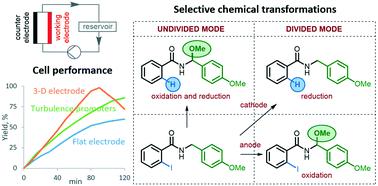当前位置:
X-MOL 学术
›
React. Chem. Eng.
›
论文详情
Our official English website, www.x-mol.net, welcomes your
feedback! (Note: you will need to create a separate account there.)
A design of flow electrolysis cell for ‘Home’ fabrication
Reaction Chemistry & Engineering ( IF 3.4 ) Pub Date : 2020-02-27 , DOI: 10.1039/d0re00019a Ana A. Folgueiras-Amador 1, 2, 3, 4 , Alex E. Teuten 1, 2, 3, 4 , Derek Pletcher 1, 2, 3, 4 , Richard C. D. Brown 1, 2, 3, 4
Reaction Chemistry & Engineering ( IF 3.4 ) Pub Date : 2020-02-27 , DOI: 10.1039/d0re00019a Ana A. Folgueiras-Amador 1, 2, 3, 4 , Alex E. Teuten 1, 2, 3, 4 , Derek Pletcher 1, 2, 3, 4 , Richard C. D. Brown 1, 2, 3, 4
Affiliation

|
Despite extensive literature on organic electrosynthesis, it has never become a routine procedure in organic synthesis laboratories. One reason is certainly a lack of attention to the design of the cell used for the electrolysis; an appropriate cell is the dominant factor in determining the rate of conversion and the final conversion. Beaker cells predominate in published laboratory electrosyntheses but their use can limit reaction performance, and ease of scale-up, particularly where high rates of conversion are required without compromising selectivity for the desired product. This paper describes a simple design of a flow cell for operation in a recycle mode that is straightforward to fabricate and its performance is illustrated with anodic and cathodic electrosyntheses. The advantages of using turbulence promoters in the flow channel and a three dimensional electrode (reticulated vitreous carbon) are demonstrated. The cell allows the preparation of up to 5 mmol per hour of isolated product, and 20 mmol of product can be obtained over 4 h with high conversion of starting material. The cell design is readily scalable to enable the synthesis of larger quantities of product, and provides the capability to introduce a separator for organic electrosynthesis in a divided mode.
中文翻译:

用于“家庭”制造的流式电解槽设计
尽管有大量有关有机电合成的文献,但它从未成为有机合成实验室的常规程序。原因之一当然是缺乏对电解所用电池设计的关注。合适的单元格是确定转化率和最终转化率的主要因素。烧杯细胞在已发表的实验室电合成中占主导地位,但是它们的使用会限制反应性能,并难以扩大规模,特别是在需要高转化率而又不损害所需产物选择性的情况下。本文介绍了一种可在循环模式下操作的流通池的简单设计,该流程易于制造,并通过阳极和阴极电合成说明了其性能。证明了在流动通道和三维电极(网状玻璃碳)中使用湍流促进剂的优势。该池允许每小时制备高达5 mmol的分离产物,并且在4 h内可以高起始原料转化率获得20 mmol产物。电池设计易于扩展,可以合成更多的产品,并具有以分隔模式引入用于有机电合成的隔板的能力。
更新日期:2020-02-27
中文翻译:

用于“家庭”制造的流式电解槽设计
尽管有大量有关有机电合成的文献,但它从未成为有机合成实验室的常规程序。原因之一当然是缺乏对电解所用电池设计的关注。合适的单元格是确定转化率和最终转化率的主要因素。烧杯细胞在已发表的实验室电合成中占主导地位,但是它们的使用会限制反应性能,并难以扩大规模,特别是在需要高转化率而又不损害所需产物选择性的情况下。本文介绍了一种可在循环模式下操作的流通池的简单设计,该流程易于制造,并通过阳极和阴极电合成说明了其性能。证明了在流动通道和三维电极(网状玻璃碳)中使用湍流促进剂的优势。该池允许每小时制备高达5 mmol的分离产物,并且在4 h内可以高起始原料转化率获得20 mmol产物。电池设计易于扩展,可以合成更多的产品,并具有以分隔模式引入用于有机电合成的隔板的能力。











































 京公网安备 11010802027423号
京公网安备 11010802027423号